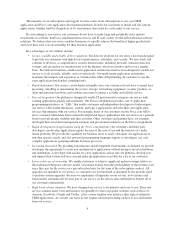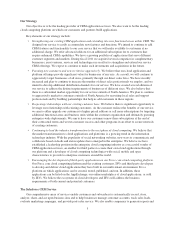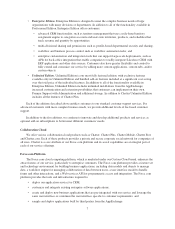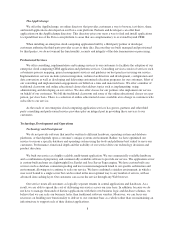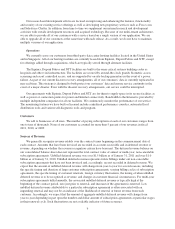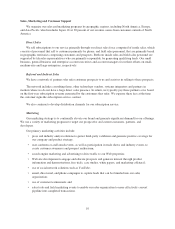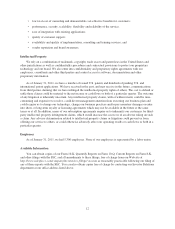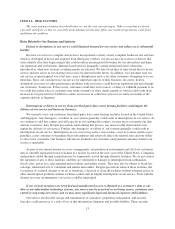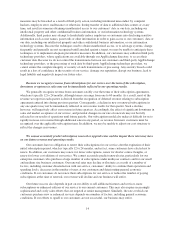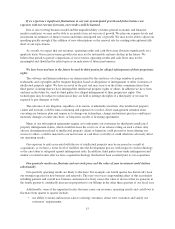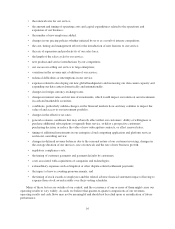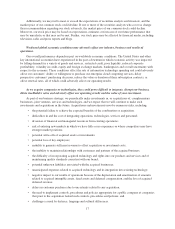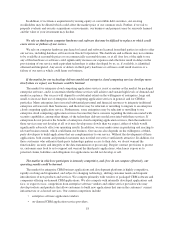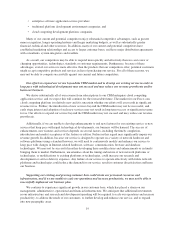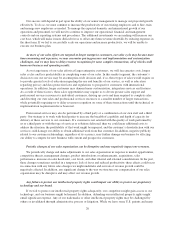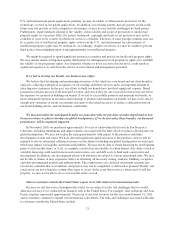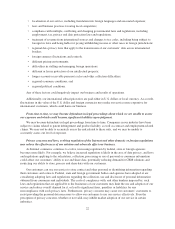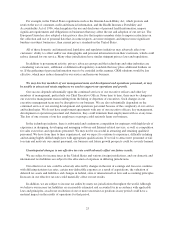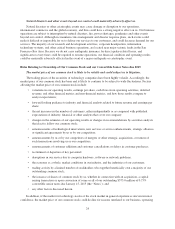Salesforce.com 2011 Annual Report Download - page 22
Download and view the complete annual report
Please find page 22 of the 2011 Salesforce.com annual report below. You can navigate through the pages in the report by either clicking on the pages listed below, or by using the keyword search tool below to find specific information within the annual report.measures may be breached as a result of third-party action, including intentional misconduct by computer
hackers, employee error, malfeasance or otherwise, during transfer of data to additional data centers or at any
time, and result in someone obtaining unauthorized access to our customers’ data or our data, including our
intellectual property and other confidential business information, or our information technology systems.
Additionally, third parties may attempt to fraudulently induce employees or customers into disclosing sensitive
information such as user names, passwords or other information in order to gain access to our customers’ data or
our data, including our intellectual property and other confidential business information, or our information
technology systems. Because the techniques used to obtain unauthorized access, or to sabotage systems, change
frequently and generally are not recognized until launched against a target, we may be unable to anticipate these
techniques or to implement adequate preventative measures. In addition, our customers may authorize third party
technology providers, whose applications are available through our AppExchange directory, to access their
customer data. Because we do not control the transmissions between our customers and third-party AppExchange
technology providers, or the processing of such data by third-party AppExchange technology providers, we
cannot ensure the complete integrity or security of such transmissions or processing. Any security breach could
result in a loss of confidence in the security of our service, damage our reputation, disrupt our business, lead to
legal liability and negatively impact our future sales.
Because we recognize revenue from subscriptions for our service over the term of the subscription,
downturns or upturns in sales may not be immediately reflected in our operating results.
We generally recognize revenue from customers ratably over the terms of their subscription agreements,
which are typically 12 to 24 months, although terms can range from one to 60 months. As a result, most of the
revenue we report in each quarter is derived from the recognition of deferred revenue relating to subscription
agreements entered into during previous quarters. Consequently, a decline in new or renewed subscriptions in
any one quarter may not be immediately reflected in our revenue results for that quarter. Such a decline,
however, will negatively affect our revenue in future quarters. Accordingly, the effect of significant downturns in
sales and market acceptance of our service, and potential changes in our rate of renewals may not be fully
reflected in our results of operations until future periods. Our subscription model also makes it difficult for us to
rapidly increase our revenue through additional sales in any period, as revenue from new customers must be
recognized over the applicable subscription term. In addition, we may be unable to adjust our cost structure to
reflect the changes in revenues.
We cannot accurately predict subscription renewal or upgrade rates and the impact these rates may have
on our future revenue and operating results.
Our customers have no obligation to renew their subscriptions for our service after the expiration of their
initial subscription period, which is typically 12 to 24 months, and in fact, some customers have elected not to
renew. In addition, our customers may renew for fewer subscriptions, renew for shorter contract lengths, or
renew for lower cost editions of our service. We cannot accurately predict renewal rates, particularly for our
enterprise customers who purchase a large number of subscriptions under multiyear contracts and for our small
and medium size business customers. Our renewal rates may decline or fluctuate as a result of a number of
factors, including customer dissatisfaction with our service, customers’ ability to continue their operations and
spending levels, decreases in the number of users at our customers and deteriorating general economic
conditions. If our customers do not renew their subscriptions for our service or reduce the number of paying
subscriptions at the time of renewal, our revenue will decline and our business will suffer.
Our future success also depends in part on our ability to sell additional features and services, more
subscriptions or enhanced editions of our service to our current customers. This may also require increasingly
sophisticated and costly sales efforts that are targeted at senior management. Similarly, the rate at which our
customers purchase new or enhanced services depends on a number of factors, including general economic
conditions. If our efforts to upsell to our customers are not successful, our business may suffer.
14


